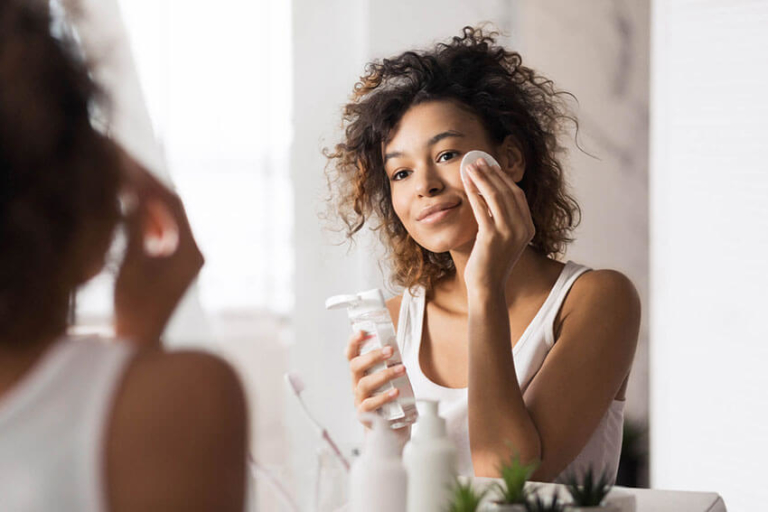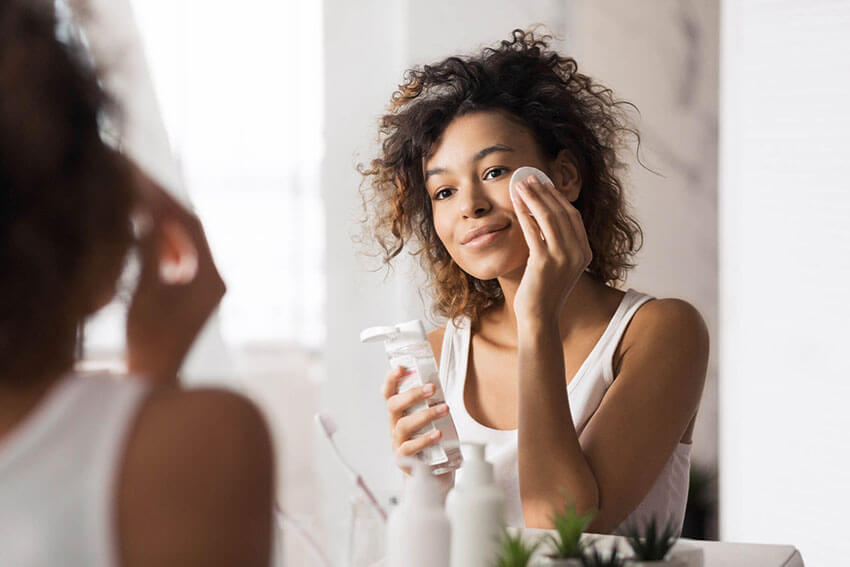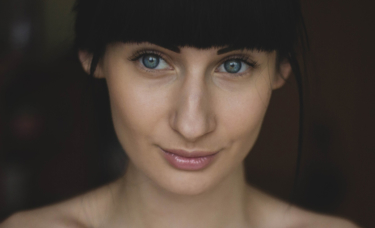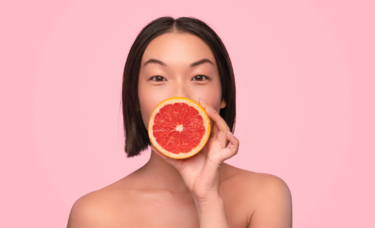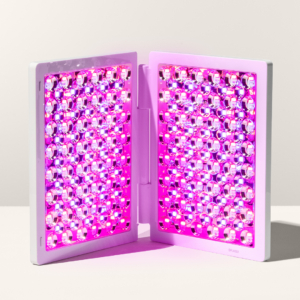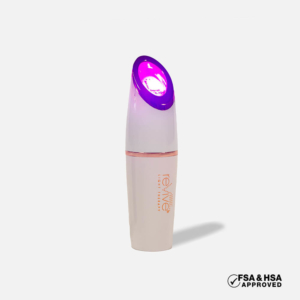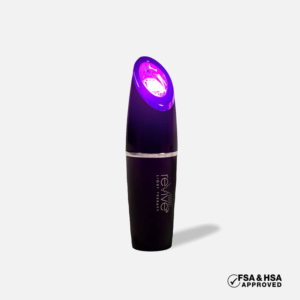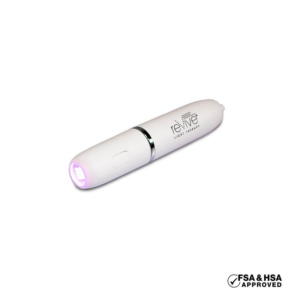Your Daily Skincare Routine Order Matters – Here’s Why
Have you spent your mornings and nights facing an array of skincare products on your bathroom counter that are staring you in the face?
Knowing what order to use your skincare products in can be intimidating, especially if you’re just starting to build your skincare routine. However, it’s an important part of maximizing the benefits of your skincare products.
Table of Contents
Why is the Order of My Skincare Routine Important?
The sequence of your routine may seem arbitrary at first glance, but there’s actually a scientific method to layering skincare products and light therapy that gives you the best results. If you don’t apply products in the correct order, you could be at risk of the following scenarios:
- Skincare products may not fully penetrate: If you put on richer, creamier, thicker products before thin, fluid or water-based products, they may not be effective because the richer products can form a barrier that prevents anything else from getting through.
- Skincare products may be less effective: If the products are unable to penetrate the skin properly, you won’t be able to get the full benefits. And, active ingredients can mix in different ways that can nullify their intended effect.
- Skincare products may be harmful: Incorrect layering of products can potentially cause harm to your skin. For example, applying serums on top of oils can leave your skin dry and dehydrated. And, applying thicker products on top of sunscreen can cause your sunscreen coverage to become less effective, thus leaving your skin vulnerable to sunburn.
Putting Your Skincare Routine in Order
While certain steps are common knowledge, such as cleansing before you moisturize, other steps are trickier. For example, is it better to apply moisturizer or serum first? Should your morning and evening routines look the same or should they each have unique characteristics? When should you use your light therapy device to maximize results, and do certain types of lights work better depending on the time of day?
It’s easy to overthink your skincare routine, but if you follow these simple guidelines, you’ll be a skincare expert in no time.
What Type of Light Therapy Works Best in the Mornings vs. the Evenings?
Good news — the time of day has no bearing on light therapy performance. That means that the type of light therapy treatment you use in the mornings and evenings ultimately boils down to your skincare goals. For example, if you really want to focus on wrinkle reduction and prevention, then you may want to use red light therapy in the morning and in the evening — and the same goes for blue light if you mainly want to tackle acne concerns.
If you want to combat both acne and anti-aging concerns, you may consider using blue light in the morning and red light in the evening, or vice versa. Or, you could even do a blue light and red light treatment in the mornings and evenings, which can be easily achieved with a device that administers both forms of light.
Whether you choose to use blue light or red light therapy, or a combination of the two, we have you covered when it comes to layering light therapy with other skincare products for the ideal morning and evening routine.
The Best Skincare Routine Order: A Step-by-Step Guide
When you build out your skincare routine, the three main steps are to:
- Cleanse: Remove impurities.
- Tone: Balance the skin.
- Moisturize: Hydrate the skin.
Seems easy, right? What can complicate things is that some products don’t necessarily fall into one of these categories. Or, you may use two products that have similar benefits but don’t behave the same way on your skin. Take serums, face oils and moisturizers, for example. They often tackle similar concerns, but which order should you apply them in?
Below is a handy graphic that you can screenshot, or save on Instagram or Pinterest, as a reference that covers the ideal step-by-step skincare routine for both mornings and evenings.
*Important note: use serums before light therapy only if they do not contain retinol or SPF.
As shown in our graphic guide, morning and evening routines follow a similar core structure to achieve the best results. Below, we break down each step so you can better understand the importance of this layering technique.
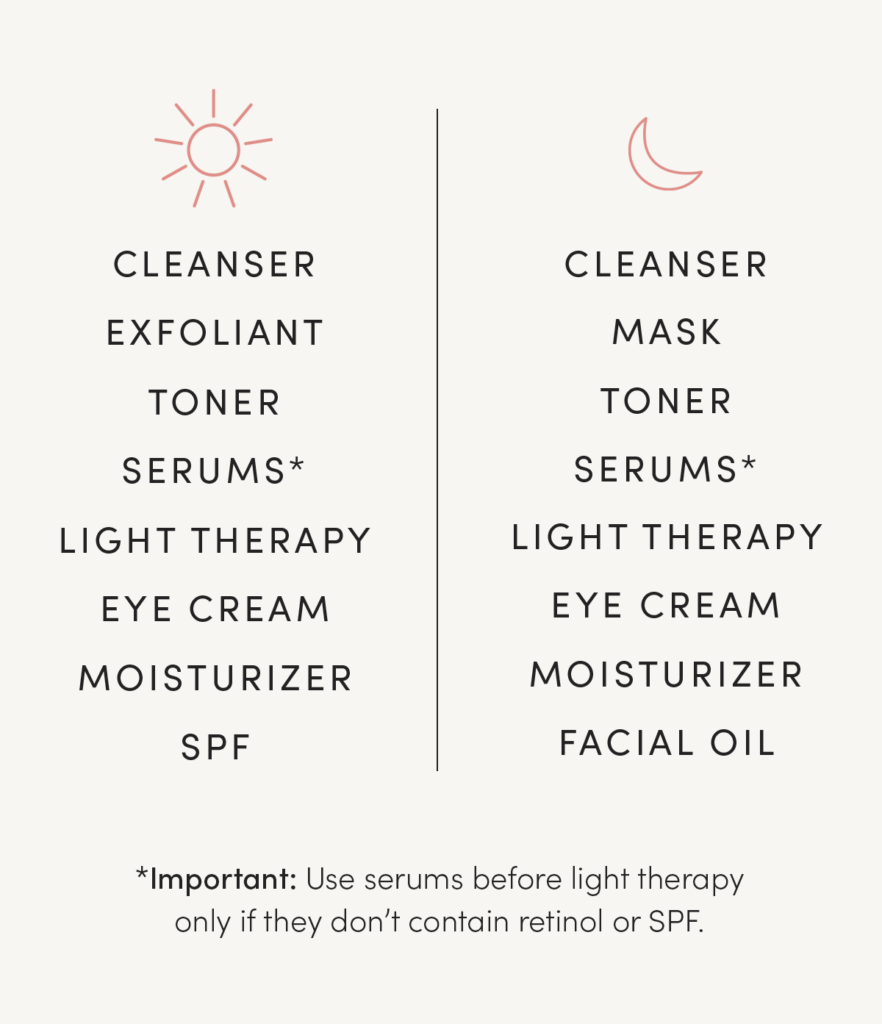
Your Daytime Skincare Routine
Step 1: Cleanse
All good skincare routines start with a fresh, clean face. For the active ingredients in your skincare products to best do their job, you need to remove all of those impurities from your skin’s surface and pores. In the morning (assuming you didn’t — gasp — sleep with your makeup on), you should be good-to-go with your typical facial cleanser.
However, at night, if you have makeup on, you will want to use a makeup remover or an oil cleanser before your usual facial cleanser. When you use an oil cleanser before your typical cleanser, that is called double-cleansing — which is a method that many skincare gurus recommend. This two-step process ensures the cleanest skin possible without stripping your skin of its natural oils or doing any harsh damage.
Step 2: Exfoliate
Exfoliating is the next step but remember that you should only partake in this step one to three times a week, depending on your skin type and the recommendations on the product label. Exfoliation is the process of removing built-up dead skin cells. At the rate we shed facial skin cells, exfoliating just once a week should suffice for beginners or for those with sensitive skin. If you have oily or acne-prone skin, you may want to experiment with exfoliating twice or up to three times a week.
Step 3: Tone
Facial toner should come after cleansing and before applying any type of serum, moisturizer or oil. Toner is meant to pick up any leftover debris that your cleanser or exfoliant may have not picked up while simultaneously prepping your skin to absorb serums, moisturizers, oils and other skincare products.
If you’re new to using toner, there are a variety of options available that are tailored to unique skincare concerns. If you have dry skin, you can choose a toner with hydrating effects, such as one with rosewater or Vitamin E. Or, if you have sensitive skin, you may want a toner that has soothing effects and includes ingredients like chamomile or aloe vera.
Step 4: Serums
Serums are concentrated doses of nutrients or specialized active ingredients, and usually target concerns like skin brightness, hydration, radiance and anti-aging. Since serums deliver concentrated doses of active ingredients, it makes most sense to apply this thin, liquid based product before heavy products like moisturizers, which could block your skin’s absorption of the serum.
Serums, like Vitamin C, work well in conjunction with LED light therapy and increase the effectiveness of both treatments for your skin.
Step 5: Light therapy
Now that your skin is completely clear, it is the best time to use your favorite light therapy products. Red light therapy will significantly help with any anti-aging concerns, boosting your skin’s overall tone, color and radiance, while reversing fine lines and wrinkles. It can even help minimize the effects of sun damage and reduce redness, inflammation and swelling.
Blue light therapy, on the other hand, is a powerful solution for any acne concerns you may have. Remember, the time of day has no bearing on the effects of your light therapy treatment, so you are free to choose any combination or variation of red and blue light therapy depending on your skincare goals.
Step 6: Eye cream
Since you should apply products with a thinner consistency before products with a thicker, heavier texture, eye creams should be applied before moisturizers. Many skincare routines call for eye cream because the eyelids are the most delicate area of the face, and a little extra TLC goes a long way.
In the mornings, an eye cream that helps reduce the appearance of under-eye bags or dark circles can be helpful. In the evenings, you may want to opt for an eye cream that focuses on hydration or contains retinol for added wrinkle prevention and control.
Step 7: Moisturizer
Keeping the skin hydrated is essential for healthy, glowing skin. If you have naturally oily skin, you may think that is a step that you should skip. However, it is still recommended by dermatologists for those with oily skin to moisturize daily. If you are acne-prone, most dermatologists recommended a moisturizer that is oil-free and that won’t clog pores.
Step 8: Sunscreen or facial oil
In the mornings, sunscreen should be your final last step. Guard your skin against harmful UV rays, even if you don’t plan to spend hours outdoors. Taking this extra step helps preserve your skin’s youthfulness, firmness and overall texture in the long run.
If you have a facial oil product, this is great for the evenings and should be the last product you apply. Facial oils often act as a final seal to all of the skincare products you applied beforehand. And most important to note is that most skincare products cannot penetrate and break through oil, which is why it should always be the last step in your routine.
Your nighttime skincare routine
The main difference between your daytime vs. your nighttime routine that we recommend is applying a mask after you cleanse. The evenings are a perfect time for applying a relaxing facial mask. Just like exfoliating, this is not recommended to be applied daily. For best results, you should follow the instructions on your facial mask’s packaging. Some masks are recommended to be applied just once a week, while others can be applied a few times a week.
Find your perfect skincare routine
The most important thing about creating your skincare routine is to do what works best for you and find something that you’ll be able to follow on a regular basis. Many skin care products are FSA eligible, giving you the opportunity to find what works best for you.
At reVive Light Therapy™, we’re passionate about creating products that make your skincare routine easy, and sharing health and beauty tips to help you live your best life. Our blog has information about how LED light therapy can help you own your skincare goals and feel confident in your own skin. Our products are designed to help you with acne, wrinkle reduction and more. View our LED light therapy skincare products.
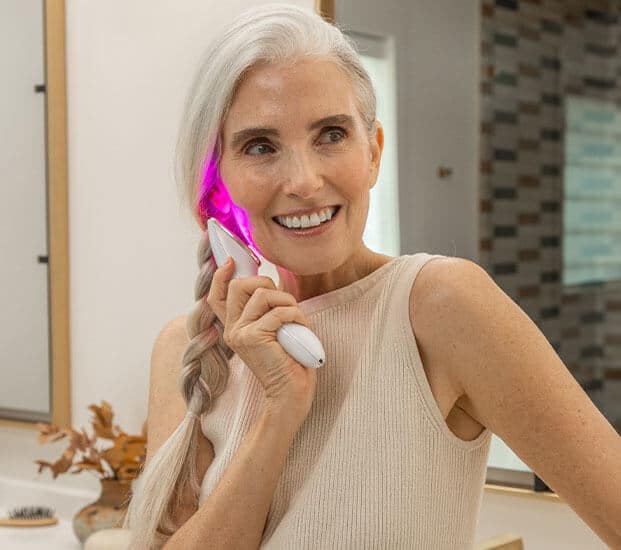
Experience the power of light therapy at home
Specific wavelengths of light have different effects, and can be used for a variety of applications — from destroying acne-causing bacteria to killing harmful germs on your phone. Our light therapy devices allow you to harness the power of LEDs in the comfort of your own home.
See How It Works